| |
There
are currently 120 protected sites called National Monuments. The
President of the United States can establish a national monument by
proclamation under the Antiquities Act or Congress can do so by
legislation. The original purpose was to protect natural wonders and
archaeological sites: 64 National Monuments have natural significance
and 24 are associated with ancient human settlements or archeological
sites. However, 33 are historical sites, including 12 forts. In
choosing my "top ten" National Monuments I have limited my choices to
natural or pre-history sites — leaving three sites preserving American
history as bonus choices for a second page
on Monuments. Like National Parks, the number of National Monuments has
increased substantially since the 64 that I learned about as a child.*
I
particularly enjoy National Monuments that are remote and require an
effort to visit. Many are at the end of a road that exists only because
they exist — examples include Devils Postpile, Chiricahua, Organ Pipe,
and Oregon Caves National Monuments, not to mention Pinnacles National
Park, which long had National Monument status. Others (e.g., Rainbow
Bridge, Navaho) are very remote and require hiking to reach them. |
|
| |
| 1 |
Natural Bridges NM Utah |
|
|
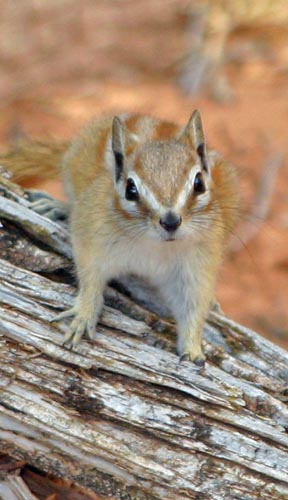 |
Natural Bridges NM in colorful southeastern Utah protects three sandstone bridges with Hopi names. The most dramatic may be Owachomo Bridge (above), the oldest and most fragile, which is near the park road. The others require some hiking. Kachina Bridge (right) is the most massive (and youngest) but Sipapu Bridge
(below) has the longest span (255 ft.) and is 144 ft. above the
riverbed below. Its span is the 10th longest in the world; 3rd longest
in North America. Each is dramatic — the combo of all three within a
just 12 square miles makes this a wonderful visit.
Rivers
(dry in summer) crisscross the mesa, cut the canyons, and created the
natural bridges. The cedar-topped mesa habitat has characteristic birds
and Hopi Chipmunk (left), an endemic of the four-corners region.
National Geographic
publicized the bridges in 1904 and the area was designated a National
Monument in 1908 by President Theodore Roosevelt. The site was nearly
inaccessible for many decades, requiring a 3-day horseback ride. Utah
Rte. 95 was paved in 1976 but the monument is still 'off the beaten
track.' It so remote it has one of the darkest skies at night in the
U.S.
|
|
|
|
|
| |
| |
|
|
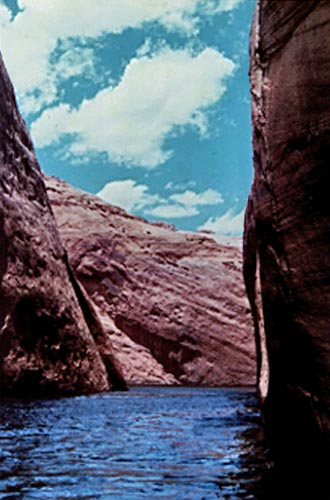 |
Rainbow Bridge
was traditionally considered the longest land bridge on earth but
modern re-measurements and discoveries elsewhere proved it is not. Yet,
because of its size and perfect shape – a "rainbow turned to stone"
said ancient native Americans —it perhaps remains the most impressive
natural bridge on earth.
Getting to
Rainbow Bridge once required a 14-mile hike or mule trip and an
overnight camp. Teddy Roosevelt did that. In 1963, Glen Canyon Dam
created Lake Powell (left), drowning some of America's most lovely canyons. Since then you take a 2 hour boat ride and hike a mile.
I
visited with my dad when I was 15 years old. These photos are digitized
from my Kodak Brownie prints, leaving less than sharp and oddly colored
shots. At a distance (right) towering cliffs dominate but no photo
captures its impact when you are close.
|
|
|
|
| |
| |
| 3 |
Dinosaur NM Utah / Colorado |
|
|
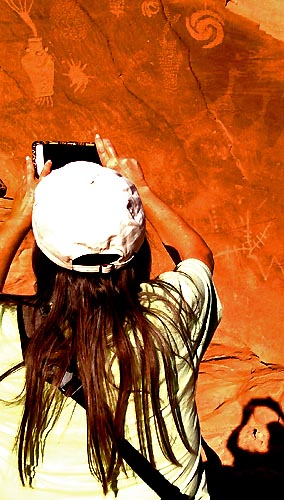 |
In
1915, 80 acres were designated in eastern Utah as Dinosaur NM to
preserve a huge quarry of Jurassic era dinosaur fossils. Discovered in
1909, the majority were excavated for Carnegie Museum. Only a quarter
of the original hill remains, but the inside of the hill —studded with
fossils in situ — today constitutes the back 'wall' of a two-story visitor's center. A reconstructed Allosaurus striding beside a late Jurassic mural is among highlights away from the wall of fossilized bones (above).
The
original 80 acres were expanded to 210,000 acres (328 sq mi) by
Franklin Roosevelt, most of it in western Colorado, such the Yampa
River canyons at Echo Park (below). There are also marvelous 1,000 year
old petroglyphs (left), old homesteads to visit, and much opportunity for wildlife viewing (Dusky Grouse, right).
|
|
|
|
| |
| |
| 4 |
Bandelier NM New Mexico |
|
|
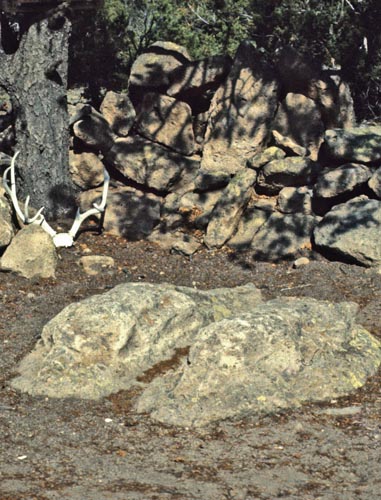 |
Bandelier
NM combines natural scenery with the ruins of an ancient civilization.
Set in the Jemez Mts. of northern New Mexico, it was settled by
Ancestral Pueblo people from 1150-1550AD. They abandoned after a
prolonged drought, and moved to the Rio Grande Valley. Ruins from the
ancient civilization abound, from the Tyuoni Ruin (above, the ruin is in the foreground) to the walls of Painted Cave (below) to a pair of carved stone lions (left) whose shape can still be seen 450 years later.
I visited when I was 18, and enjoyed a quick dip in Upper Frijoles Falls
(right) on a hot summer afternoon. That was a 3 mile roundtrip hike.
The stone lions was 13 miles roundtrip — something I'm glad I did when
I was young!
|
|
|
|
|
| |
| |
| 5 |
Devils Postpile NM California |
|
|
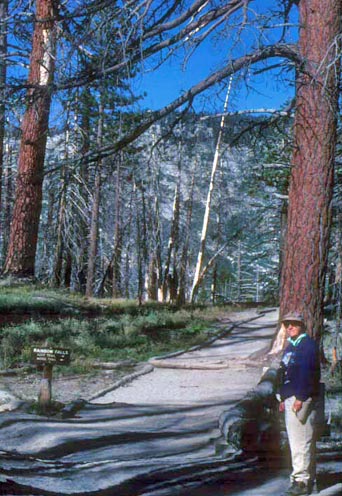 |
The Devils Postpile
formation is a wall of polygonal basaltic columns 60 ft. high, created
by the cooling and cracking of hot lava (above & right). Fallen and
broken columns at the base create a jumble of rocks. At the time of our
visit in 1998, a recent fire had created a moonscape of burnt trees
(left) which hosted a rare Black-backed Woodpecker.
Situated
at 7500' elevation on the western slope of the Sierra Nevada -- and
open only during the summer -- it is reached by a winding and narrow
road only from the east slope (via Mammoth Lakes). There is a
campground for overnight stays, but even during a day visit one can
overlook 101 ft. high Rainbow Falls on the Middle Fork San Joaquin River (below) via a trail through the forest.
|
|
|
|
| |
| |
| 6 |
Devils Tower NM Wyoming |
|
|
 |
Devils Tower
became our first National Monument when established by President
Theodore Roosevelt in 1906. Little did anyone then know it would become
famous to a modern generation as the fictional setting for the
Spielberg movie Close Encounters of the Third Kind. . . .
Like many National Monuments established long ago, the land preserved
was of minimal size — only a tad over 2 sq.mi. One almost runs into the
Tower when the entrance sign appears (below). There is just enough room
for the Tower and a colony of Black-tailed Prairie-dogs (right). Still, Devils Tower is a natural and enduring icon. |
|
|
|
|
| |
| |
|
|
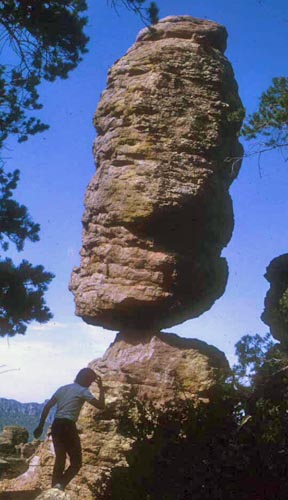 |
Chiricahua
NM is nestled within the northwestern slope of Arizona's Chiricahua
Mts., and a long ways by road from the main birding spots on the
southeastern slopes. I've birded the Chiricahuas a dozen times but only
once managed to reach this magical place, where rocks have names and
personalities. Punch & Judy (above) bicker in perpetuity. Pinnacle Rock (left) threatens to topple. And one can get lost among the towers of Echo Canyon (below), to name just a few highlights. But watch your step on the trails — it is also the home of the beautiful Black-tailed Rattlesnake (right). |
|
|
|
| |
| |
| 8 |
Canyon de Chelley NM Arizona |
|
|
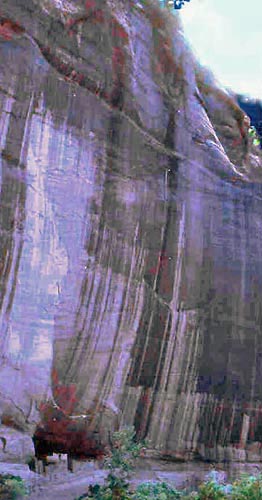 |
Canyon de Chelley [pronounced
"de Shay"] is a mesmerizing locales. The winding canyons with sandy
bottoms are stark and unworldly (above), and scattered among the walls
are remote ruins of ancient civilizations. All my old photos came out
in weird shades of pink and purple that even I can't fix in PhotoShop.
My first visit was when I was a teenager with my father, and we joined a Navajo-run tour to White House Ruin (left — in cave at base of huge cliff— and below), using a multi-tired truck
with very wide tires to drive on the sandy canyon bottom (right)..
Among the many National Monuments featuring antiquities, the landscape
in Canyon de Chelley was among the most memorable.
|
|
|
|
| |
| |
| 9 |
Oregon Caves NM & Preserve Oregon |
|
|
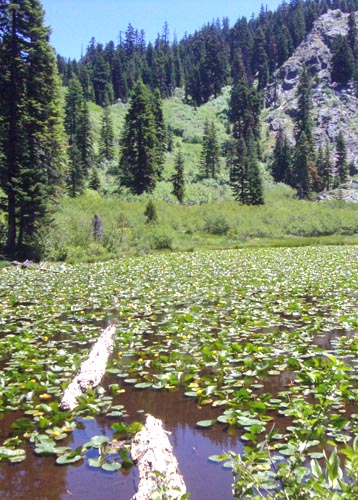 |
There
are 4 National Parks (Carlsbad Caverns, Mammoth Cave, Wind Cave, and
Great Basin -- once Lehman Caves NM) and 3 National Monuments centered
around impressive formations within natural caves. Oregon Caves was
among the first protected in 1909 in remote sw. Oregon (cave entrance above). It has a variety of calcite formations within a many-chambered marble cave (below, 'Washington Monument,'
among the sites on the 90-min tour). In Dec 2014 the Monument was
expanded nearly ten-fold to add a Preserve, including lovely Bigelow Lake (left). This expansion, plus the elegant 1936-built Chateau at which we stayed (right), pushes this Monument into my 'top ten.' |
|
|
|
| |
| |
| 10 |
Carrizo Plain NM California |
|
|
 |
All
of the preceding National Monuments are managed by the National Park
Service. In recent decades, Presidents Clinton and Obama have created
National Monuments from Bureau of Land Management (BLM) property, and a
number of these are still administered by BLM.
One fine example is the arid Carrizo Plain in eastern San Luis Obispo Co. Saline lakes in the valley (below) provide winter habitat for cranes and waterfowl. Year-round residents include Bell's Sparrow (left) and Pronghorn (right). Much of the time it is dry and hot.
Except
— there are those irregular years when the timing of rains is just
right for a riotous wildflower show in April-May. 1991 was a great year
(above & right) when vivid fields of wildflowers painted the arid
landscape into modern art masterpieces.
|
|
|
|
| |
|
| |
|
| |
|
|
|
|
|
| |
| *
Footnote: By 1950, two National Monuments listed in earlier editions of
my childhood book had been demoted to Forest Service land (Holy Cross,
Wheeler) as not meeting National Monument standards; these are not
counted in the 64 National Monuments of my childhood. Most of the 64
Monuments that I learned as a kid remain National Monuments. However,
14 have since been elevated to National Park status; one (Chaco Canyon)
became a National Historical Park; and two were decommissioned (Fossil
Cycad — vandals looted and stole all visible fossil cycads; Old Kasaan
— all totems and relics moved to other sites). Another National
Monument that I visited in 1970 was Pecos NM, created in 1965, but it
became a National Historical Park in 1990. In some ways this parallels
my personal quest to see all the bird families in the world — an
ever-changed target with new molecular evidence — and with National
Monuments, what is and is not currently a holder of that status is
subject to the whims of politics. |
|
CREDITS — photos & text © Don Roberson
except as otherwise indicated |
|
|
|
|
|